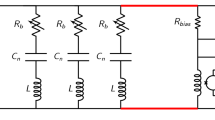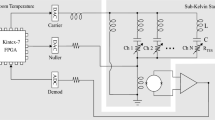Abstract
POLARBEAR-2b (PB-2b) is the second of three cryogenic receivers of the Simons Array cosmic microwave background polarization experiment. PB-2b contains over 7500 transition-edge sensor (TES) bolometers cooled to 250 mK and read out using digital frequency-division multiplexing (DfMux). Stray impedance in the DfMux circuit obscures TES characterization and affects TES dynamic behavior. In order to accurately characterize TESs, it is necessary to account for stray impedance in the bias circuit. We define a stray impedance model, and we describe the technique used to measure model parameters in situ and to remove their effects on TES characterization. We use the same model to predict TES dynamic behavior and show good agreement between data and the model.





Similar content being viewed by others
References
P.A.R. Ade et al., Phys. Rev. Lett. 112, 131302 (2014). https://doi.org/10.1103/PhysRevLett.112.131302
P.A.R. Ade et al., Phys. Rev. Lett. 113, 021301 (2014). https://doi.org/10.1103/PhysRevLett.113.021301
P.A.R. Ade et al., Ap. J. 794, 171 (2014). https://doi.org/10.1088/0004-637x/794/2/171
P.A.R. Ade et al., Phys. Rev. D 92, 123509 (2015). https://doi.org/10.1103/PhysRevD.92.123509
P.A.R. Ade et al., Ap. J. 848, 121 (2017). https://doi.org/10.3847/1538-4357/aa8e9f
K. Arnold et al., Millimeter, Submillimeter, and Far-Infrared Detectors and Instrumentation for Astronomy V, vol. 7741 (SPIE, Bellingham, 2010). https://doi.org/10.1117/12.858314
Z.D. Kermish et al., Millimeter, Submillimeter, and Far-Infrared Detectors and Instrumentation for Astronomy VI, vol. 8452 (SPIE, Bellingham, 2012). https://doi.org/10.1117/12.926354
A. Suzuki et al., J. Low Temp. Phys. 184, 805 (2016). https://doi.org/10.1007/s10909-015-1425-4
N. Stebor et al., Millimeter, Submillimeter, and Far-Infrared Detectors and Instrumentation for Astronomy VIII, vol. 9914 (SPIE, Bellingham, 2016). https://doi.org/10.1117/12.2233103
M. Dobbs et al., Rev. Sci. Instrum. 83, 073113 (2012). https://doi.org/10.1063/1.4737629
T. de Haan et al., Millimeter, Submillimeter, and Far-Infrared Detectors and Instrumentation for Astronomy VI, vol. 8452 (SPIE, Bellingham, 2012). https://doi.org/10.1117/12.925658
A.N. Bender et al., Millimeter, Submillimeter, and Far-Infrared Detectors and Instrumentation for Astronomy VII (SPIE, Bellingham, 2014). https://doi.org/10.1117/12.2054949
J. Montgomery, Masters Thesis, McGill University, 2015
K. Hattori et al., J. Low Temp. Phys. 184, 512 (2016). https://doi.org/10.1007/s10909-015-1448-x
A. Bender et al., J. Low Temp. Phys. (2020). https://doi.org/10.1007/S10909-019-02280-W
K. Rotermund et al., J. Low Temp. Phys. 184, 486 (2016). https://doi.org/10.1007/s10909-016-1554-4
J.S. Avva et al., J. Low Temp. Phys. 193, 547 (2018). https://doi.org/10.1007/s10909-018-1965-5
T. Elleflot et al., J. Low Temp. Phys. 193, 1094 (2018). https://doi.org/10.1007/s10909-018-2058-1
D. Dutcher et al., Millimeter, submillimeter, and far-infrared detectors and instrumentation for astronomy IX, vol. 10708 (SPIE, Bellingham, 2018). https://doi.org/10.1117/12.2312451
A. Anderson et al., J. Low Temp. Phys. (2020). https://doi.org/10.1007/S10909-019-02259-7
K.D. Irwin et al., Cryog. Part. Detect. 99, 63 (2005)
Acknowledgements
The Simons Array is supported by the Simons Foundation, the National Science Foundation (AST-1440338), the Moore Foundation, and the Heising-Simons Foundation. The authors acknowledge support from the Axe Center for Experimental Cosmology and the John Templeton Foundation. This work was supported by JSPS KAKENHI Grant Number JP15H05891.
Author information
Authors and Affiliations
Corresponding author
Additional information
Publisher's Note
Springer Nature remains neutral with regard to jurisdictional claims in published maps and institutional affiliations.
Rights and permissions
About this article
Cite this article
Elleflot, T., Arnold, K., Barron, D. et al. Effect of Stray Impedance in Frequency-Division Multiplexed Readout of TES Sensors in POLARBEAR-2b. J Low Temp Phys 199, 840–848 (2020). https://doi.org/10.1007/s10909-020-02387-5
Received:
Accepted:
Published:
Issue Date:
DOI: https://doi.org/10.1007/s10909-020-02387-5




